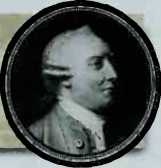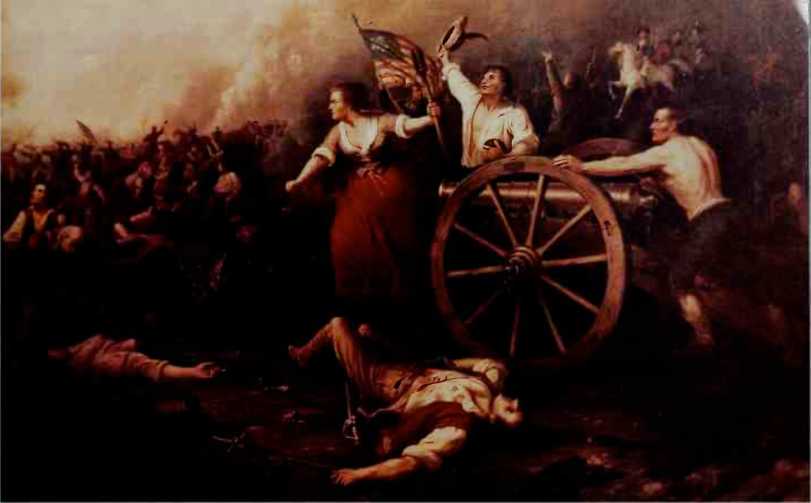American morale got a boost after Washington's victories in New Jersey. But in June 1777, word came that a large British army of 10,000 men and 138 cannons was headed south from Canada. Many thought the American Revolution would soon be over.
Saratoga. General John Burgoyne had bet a year’s wages that after one decisive blow against the Americans, he would return to England victorious. Burgoyne believed that by striking down the Hudson River he would cut off New England and New York from the rest of the colonies and end the rebellion.
After recapturing Fort Ticonderoga, Burgoyne headed toward Fort Edward. But when the Patriots saw him coming they abandoned the fort and took to the woods. Crack riflemen, positioned behind—and sometimes in— the trees, bloodied the advancing British soldiers. In a series of skirmishes, the British lost close to 1,000 men.
The attacks slowed the British down, and by the time they reached Saratoga, the Americans were ready for them. General Horatio Gates, commander of the American forces, placed his men on a high bluff called Bemus Heights, overlooking the road to Albany. American cannons were trained on the approaching
British. Burgoyne had only two choices: march down the dangerous narrow road to Albany or fight the Americans.
American farmers, led by Benedict Arnold, soon joined the furious assault upon Gates’ troops. After losing another 600 soldiers, Burgoyne, who swore he would never surrender, did just that. The Americans marched the British army to Boston and put them on ships returning to England.
The victory at Saratoga finally convinced the French to join the war on the American side.
Valley Forge. Saratoga had turned the tide of the war, but George Washington was going through some tough times. Trying to protect Philadelphia, he had lost two battles in Pennsylvania at Brandywine and Germantown. On September 26, General Howe finally captured Philadelphia. A despairing Washington brought his exhausted army to Valley Forge, Pennsylvania.
It was a good spot for a winter camp. The land was high enough so the American troops could keep an eye on Philadelphia. Yet it was far enough away that they didn’t have to worry about surprise attacks.
Unfortunately, the winter of 1777-1778 was terrible. There wasn’t enough clothing to go around, and there was never enough to eat. Nearly 2,000 soldiers died, and another 2,000 deserted. The survivors, though, emerged in the spring as a new, thoroughly trained army.
Monmouth, in June 1778, hearing that the French fleet was on the way, British General Henry Clinton pulled his troops out of Philadelphia and pushed them northward toward New York. Washington’s army caught up with him near Monmouth, New Jersey.
On June 28, Washington ordered his second in command, Charles Lee, to lead the attack on Clinton’s force. Lee, however, didn’t like Washington’s plan and issued
Some Americans refused to take arms against the British tor reasons of conscience. Members of reiigious groups like the Quakers,
Shakers, and Amish were often exempted from fighting. Those exempted, though, often had to pay for a repiacement. Quakers were particulariy outspoken against the war and refused even to pay the imposed fines.
"We cannot take up arms.. .or [help in] the destruction of our feilow creatures,’’ said a meeting of Virginia Quakers. A few were put in prison. Yet Quaker Societies continued to disown members who joined the war or
Hired a substitute to replace themselves in military service.
Although most conscientious objectors were left alone, occasionally some took abuse. In September 1779, fourteen Virginia Quakers were arrested and forced to march to Washington’s army encamped near Philadelphia. General Washington sent them home.
Some of those who refused to fight were sons of famous Patriots. Patrick Henry was probably the most outspoken advocate for war with the British. But it was his son, John Henry, who ended up in the decisive battle against the British near Saratoga. John
Henry witnessed the terrific struggle at Bemus Heights, where Burgoyne’s army was slaughtered as they tried to retreat. Though the Americans won the day, their ranks, too, were shattered in the close fighting.
After the battle, young John Henry trudged through the blood-soaked fields, searching for faces of friends lost in the fight. The sight of the broken bodies proved more than the revolutionary’s son could take. He threw down his sword and cried in anguish among his dead friends. Two months later he went home to Virginia, refusing to fight any longer.
—George IIJ, just before the Battle of Saratoga


Molly Pitcher loads the guns at Monmouth. American women fought for liberty—for their countiy and themselves.
Orders that confused the troops. In places where they might have easily advanced, he ordered them to fail back. When the retreat was reported to Washington, the commander was so amazed he had the messenger arrested for spreading false reports. Washington’s disbelief soon turned to fury, though, when he caught his second in command riding away from the battle. The general reportedly swore at Lee “until the leaves shook on the trees.”
“I have beat them. I have beat all the Americans. ”
Washington then halted the retreat and spurred his troops once again to turn and attack the enemy. The general was aching for a victory, but daylight was fading. During the night Clinton’s army slipped away.
A French force arrived in New York harbor too late
To stop the British escape. The French briefly blockaded New York, but their fleet was damaged in a storm. On August 10, however, they joined forces with the Americans for an attack on Newport, Rhode Island.
The British and Hessians had made much fun of the American militia, calling them a “flock of ducks.” But an all-black regiment, the 1st Rhode Island, forced them to choke on their words. In a series of furious assaults, the Rhode Islanders inflicted four times as many casualties on the Hessians as they took themselves.
War in the West. Long before the war began, Britain had forbidden American colonists to move west over the Appalachians. For years, though, settlers had been pushing back this frontier. Now Britain had recruited local Indian tribes as their allies and used them to attack American settlements.
A Virginian, George Rogers Clark, was determined to end the raids and made plans to seize British forts along the frontier. With about 150 hard-traveling men, he braved the white water of the Ohio River to the mouth of the Tennessee. Slipping overland through the forest he an-ived before spring in Illinois territory. By Febi-uary, Clark’s men had violently taken Vincennes in Indiana.




 World History
World History









